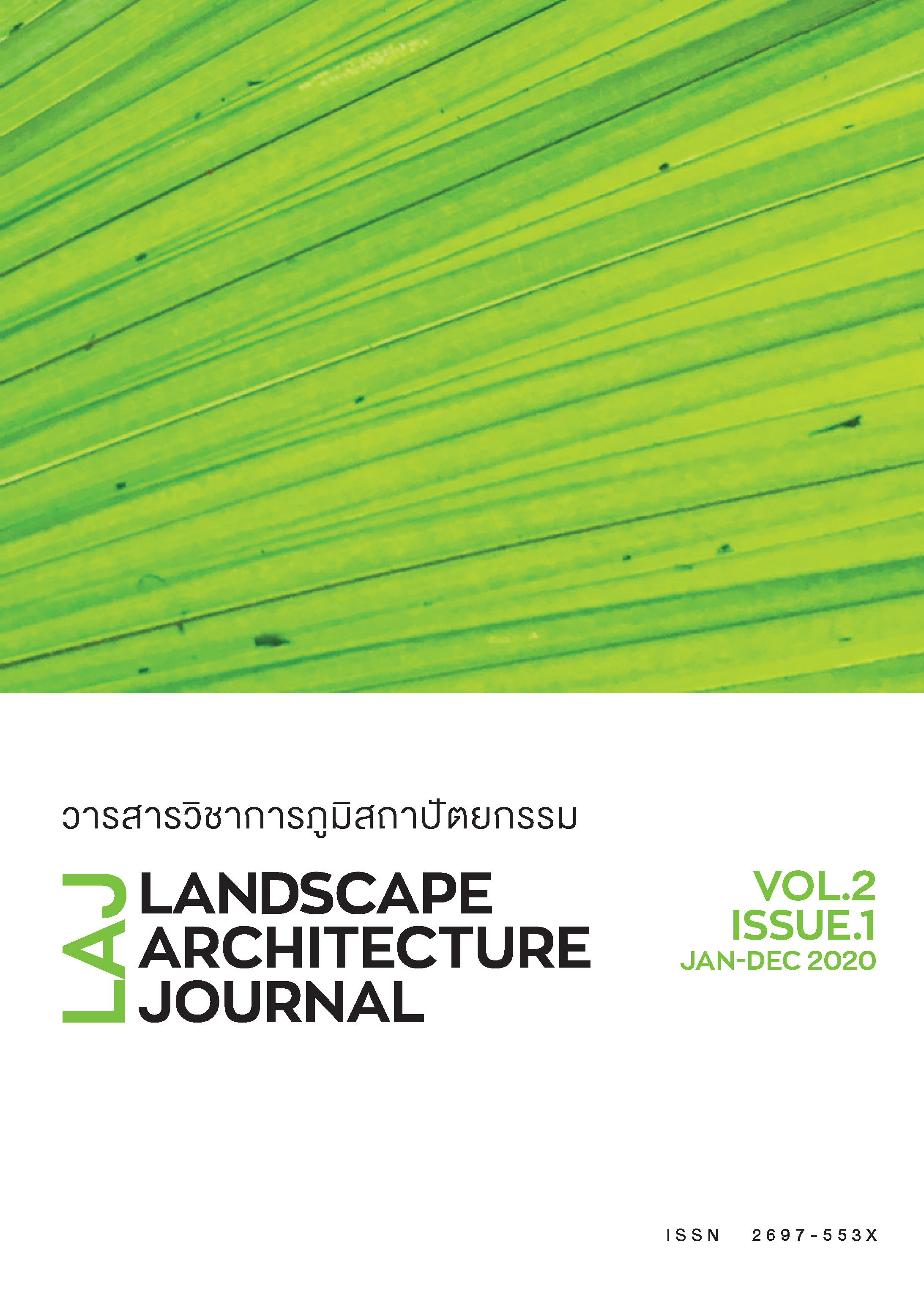Landscape Architectural Design for Elderly Residence: Jin Wellbeing County
Main Article Content
Abstract
This article describes the study of design principle and propose the Landscape architectural design for Elderly Residence. Three landscape architectural design principles include physical wellbeing, sense of community, and sustainable nature. Landscape architectural design of Jin Wellbeing County consists of conceptual design: “Community in the Ravine Forest” by designing space to engage, retreat and create; landscape planning by placing common space to be used as activity area, detention pond, and planting area in order to create natural surrounding; landscape detailed design by using landscape elements, materials, and plants which are consistent with the elderly to be convenient and safe to use. These for the elderly to realise their value and be able to live happily. Suggestions on the future projects include careful data gathering, repetition of design process, as well as evaluation from the actual usage.
Article Details

This work is licensed under a Creative Commons Attribution-NonCommercial-NoDerivatives 4.0 International License.
References
กองทุนประชากรแห่งสหประชาชาติประจำประเทศไทย. (2558). รายงานสถานการณ์ประชากรไทย พ.ศ. 2558 โฉมหน้าครอบครัวไทย ยุคเกิดน้อย อายุยืน. กรุงเทพฯ: the United Nations Population Fund Thailand and the Office of the National Economic and Social Development Board.
โครงการศูนย์บริการข้อมูลภาครัฐเพื่อประชาชน. (2563). โครงการขยายอายุเกษียณ 63 ปี. สืบค้นจาก http://www.gcc.go.th/webgcc/?p=2346#:~:text=คณะกรรมการปฏิรูปประเทศด้าน,เกษียณอายุราชการที่ 63 ปี
จิณณ์ เวลบีอิ้ง เคาน์ตี้. (2563). เมืองแห่งการดูแลผู้สูงวัย. สืบค้นจาก https://www.jinwellbeing.com/
วันทนีย์ นวลละออง. (2553). ความต้องการความรู้ ทักษะ และบริการสำหรับผู้ป่วยสูงอายุที่บ้าน : กรณีศึกษาญาติผู้ดูแลผู้ป่วยสูงอายุที่เข้ารับการรักษาในหอผู้ป่วยในโรงพยาบาลราชวิถี. กรุงเทพฯ: มหาวิทยาลัยธรรมศาสตร์.
สำนักงานสถิติแห่งชาติ. (2561). สถิติบอกอะไร ผู้สูงวัยปัจจุบันและอนาคต. สืบค้นจาก http://www.nso.go.th/sites/2014/Pages/Press_Release/2561/N10-04-61-1.aspx#:~:text=ผลจากการสำรวจประชากร,อายุ 60-69 ปี)
Chao, T.-W., Chai, C.-W., & Juan, Y.-K. (2014). Landscape design for outdoor leisure spaces at nursing homes: A case study of Taiwan Suang-Lien Elderly Centre. Journal of Food, Agriculture and Environment, 12(2), 1036-1044.
Diehl, E. (2017). Do All Gardens Heal the Same ?. City Green, 14, 68-76.
Gardner, A. H. (2004). Exploring Psychological Sense of Community in Living-Learning Programs. 108.
Hoeger, W. W. K., & Hoeger, S. A. (2005). Lifetime Physical Fitness & Wellnes; apersonalized program. In Xtemp-01.
Marques, B., McIntosh, J., & Kershaw, C. (2019). Healing spaces: Improving health and wellbeing for the elderly through therapeutic landscape design. International Journal of Arts and Humanities, 3(2), 20-34. Retrieved from https://www.researchgate.net/publication/331638162_Healing_spaces_improving_health_and_wellbeing_for_the_elderly_through_therapeutic_landscape_design
The Economist Intelligence Unit. (2019). The disappearing workforce ? Why countries in Southeast Asia need to think about fertility rates before it’s too late.
United Nations. (2019). World Population Ageing 2019. In Economic and Social Affairs, Population Division. Retrieved from http://link.springer.com/chapter/10.1007/978-94-007-5204-7_6
Velarde, M. D., Fry, G., & Tveit, M. S. (2017). Health Effects of Viewing Landscapes – Landscape Types in Environmental Psychology. Urban Forestry & Urban Greening, 199-212.
Wang, X., & Rodiek, S. (2019). Older adults’ preference for landscape features along urban park walkways in Nanjing, China. International Journal of Environmental Research and Public Health, 16(20). https://doi.org/10.3390/ijerph16203808
Wen, C., Albert, C., & Haaren, C. Von. (2018). The Elderly in Green Spaces: Exploring requirements and preferences concerning nature-based recreation. Sustainable Cities and Society, 38, 582-593.

